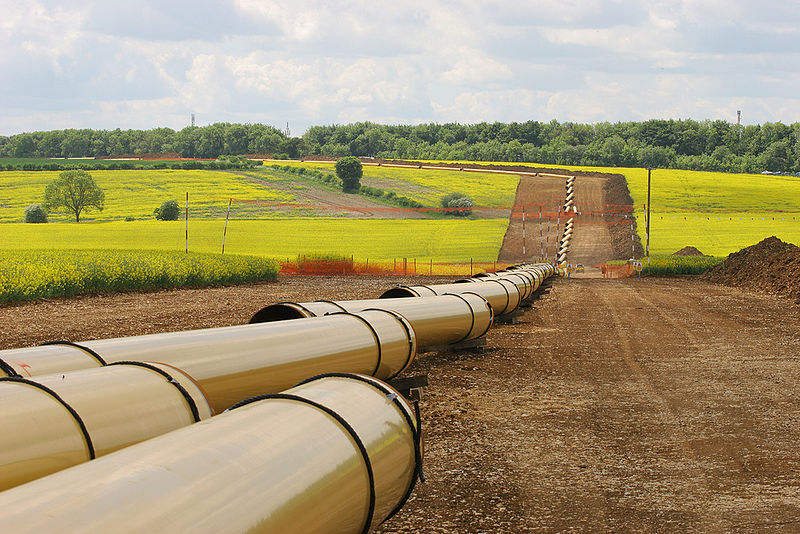Last month, the D.C. Circuit held in a 2-1 opinion that FERC was required to consider the downstream emissions created by power plants to be served by a proposed pipeline in Florida. The case not only raises questions about the scope of FERC’s NEPA review for new natural gas pipeline projects, but also about the application of the U.S. Supreme Court’s decision in Department of Transportation v. Public Citizen, 541 U.S. 752 (2004).
In Sierra Club v. Federal Energy Regulatory Commission, No. 16-1329 (D.C. Cir. Aug. 22, 2017) [hereinafter Sierra Club (Sabal Trail)], the majority of the three-judge panel found that FERC’s analysis of the downstream emissions was insufficient. Although FERC complied with NEPA with regard to environmental justice concerns, the court held that FERC’s EIS failed to adequately consider the effects of the power plant's use of the gas to generate electricity on carbon emissions.
 |
The pipeline developers argued that FERC had no obligation to consider those emissions in its NEPA analysis because it would not be the legally relevant cause of any power plant carbon emissions. The developers relied on Public Citizen, which held that an agency has no obligation to gather or consider environmental information if it has no statutory authority to act on that information. Notably, in 2016, the D.C. Circuit had also relied on Public Citizen when it thrice held that FERC, in licensing physical upgrades for an LNG terminal, need not evaluate the climate-change effects of exporting natural gas (Sierra Club v. FERC (Freeport), 827 F.3d 36 (D.C. Cir. 2016); Sierra Club v. FERC (Sabine Pass), 827 F.3d 59 (D.C. Cir. 2016); EarthReports, Inc. v. FERC, 828 F.3d 949 (D.C. Cir. 2016) [hereinafter the LNG Export Cases]). Nevertheless, the court ruled that Public Citizen did not excuse FERC from considering downstream effects here.
The court explained that in the LNG Export Cases, FERC was acting under a narrow delegation of authority from DOE and had no legal authority to prevent the adverse environmental effects of natural gas exports. Based on the facts in Sierra Club (Sabal Trail), however, Congress had broadly instructed FERC to consider the “public convenience and necessity” when evaluating pipeline construction projects under Natural Gas Act (NGA) §7. Moreover, FERC’s policy is to balance the public benefits of a project against its adverse impacts, including adverse environmental impacts. Thus, in contrast to the LNG Export Cases where FERC was prohibited from denying an export license under NGA §3 based on the indirect environmental impacts of the anticipated use of the exported gas, the D.C. Circuit reasoned that FERC could deny a pipeline certificate under a broader public interest balancing test under NGA §7 and was therefore required to consider downstream impacts. As such, the court ordered FERC to either quantify and consider the project’s downstream carbon emissions or explain in more detail why it could not do so.
A dissenting judge argued that the majority’s distinction of Public Citizen was unpersuasive. Just as DOE must approve the export of natural gas, the Florida Power Plant Siting Board must approve the construction and operation of power plants in Florida. If the required DOE approval of exports breaks the causal relationship needed to obligate FERC to quantify the downstream impacts of exports, so too should the Florida Siting Board’s required approval of power plants. On this point the majority explained that its holding in the LNG Export Cases was not based solely on the fact that a second agency’s approval was necessary before the environmental effect at issue could occur. Rather, those cases rested on the premise that FERC had no legal authority to prevent the adverse environmental effects of natural gas exports. Yet, surely the dissent would not see this as an explanation for its concerns, as FERC has no legal authority to prevent the adverse impacts—the emissions—from power plants in Sierra Club (Sabal Trail).
The judges on the D.C. Circuit may have differing views concerning Public Citizen’s “break the causal chain” rationale, but this should not affect the outcome of FERC’s deliberations. Rather, what remains is the “reasonably foreseeable” test of determining whether a sufficient causal connection exists between an approved action and indirect downstream or upstream environmental impacts. As the Supreme Court stated in Public Citizen, “but-for causation is insufficient to make an agency responsible for a particular effect under NEPA and the relevant regulations. NEPA requires a ‘reasonably close causal relationship’ akin to proximate cause in tort law.”
When looked at under the “reasonably foreseeable” standard, the D.C. Circuit’s resolution in Sierra Club (Sabal Trail) appears reasonable. All of the capacity of the proposed pipeline project was contractually committed to serve two power plants, the volume of gas could reasonably be projected based on the volumes contracted for, and the precise use of the gas to be delivered was known. But this is not always the case, as the end use and/or volumes flowing through pipelines are not always reasonably foreseeable. Examples include pipelines that are intended to serve marketing companies, producers, local distribution gas requirements, or LNG export terminals. The end use of the gas in these situations depends on where and to whom the gas is subsequently delivered. In other cases, the proposed pipeline’s capacity may be only partially committed under firm contracts at the time FERC performs its NEPA analysis. Here again, the ultimate end use of all of the gas that will be delivered by the pipeline may not be reasonably foreseeable.
Despite the D.C. Circuit’s internal split regarding Public Citizen, FERC will likely continue to decide the extent to which it will quantify indirect environmental impacts through the application of a “reasonably foreseeable” test. What this case is sure to change is the parties’ arguments both for and against the need for FERC to analyze indirect upstream and downstream impacts, and the need for FERC to respond to such arguments in greater detail than it has in the past.


